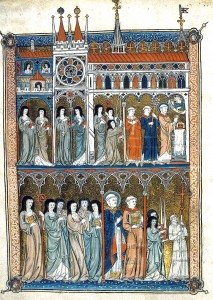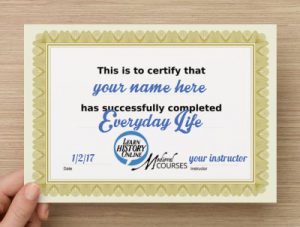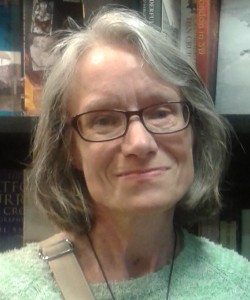 We always hear about medieval kings, queens and nobility, yet we rarely get to hear about the normal everyday people of the times. In this twenty-part course, historian Toni Mount outlines the daily routines and specialisms that various types of people had in the medieval era. Delving deep into her research on the subject and using primary sources, Toni has uncovered the names of specific, real people and uses records of their lives to give us an insight into what it was really like to live in the medieval world.
We always hear about medieval kings, queens and nobility, yet we rarely get to hear about the normal everyday people of the times. In this twenty-part course, historian Toni Mount outlines the daily routines and specialisms that various types of people had in the medieval era. Delving deep into her research on the subject and using primary sources, Toni has uncovered the names of specific, real people and uses records of their lives to give us an insight into what it was really like to live in the medieval world.
Carefully and lovingly narrated by Claire Ridgway, you'll discover that life was more fun, more vivid and more difficult than you could possibly have imagined.
Note: This is an online course of downloadable or streaming audio lectures which can be done in your own time and you have lifetime access to the course once you have signed up and paid. There is no set start or end date, you can do it at your own pace.
Click on "Full description" to find out more and click on the "Buy Now" tab to sign up and purchase.
- Buy NOW
- What's included
- Course Expert
- Reviews
- Questions
- Gift Certificate

- 9 hours 49 minutes of audio - both streaming and downloadable mp3 files.
- Downloadable PDF transcripts of each lecture.
- End of unit quizzes.
- Bibliography and further reading list.
- End of course certificate.
 Toni Mount is an author, history teacher and an enthusiastic life-long-learner. She's a member of the Research Committee of the Richard III Society and a library volunteer where she leads a Creative Writing group. She attends history events as a costumed interpreter.
Toni Mount is an author, history teacher and an enthusiastic life-long-learner. She's a member of the Research Committee of the Richard III Society and a library volunteer where she leads a Creative Writing group. She attends history events as a costumed interpreter.
She earned her research MA from the University of Kent in 2009 through study of a medieval medical manuscript held at the Wellcome Library in London. Her BA (with First-class Honours) and her Diploma in European Humanities are from the Open University. Her Cert. Ed (in Post-Compulsory Education and Training) is from the University of Greenwich. Recently, she completed a Diploma in Literature and Creative Writing with the Open University. She's currently studying a range of modules on contemporary science and technology also with the OU.
Toni has written and published books including The Medieval Housewife & Other Women of the Middle Ages, Dragon's Blood & Willow Bark : The Mysteries of Medieval Medicine, Everyday Life in Medieval London, and Richard III King of Controversy.
 After purchasing this gift certificate you will be redirected to a page with a printable gift certificate code. This code will enable the user to have FULL ACCESS to the course you have chosen, when redeemed.
After purchasing this gift certificate you will be redirected to a page with a printable gift certificate code. This code will enable the user to have FULL ACCESS to the course you have chosen, when redeemed.
Make the day of a history lover with these gift certificates...
CLICK HERE TO BUY
| Module 1 | The Merchant's Tale | |
|---|---|---|
| During the Middle Ages, England grew rich on wool. Even today the Lord Chancellor sits in Parliament upon a wool sack, as a reminder that England’s wealth and prosperity were derived from her exports in the wool trade. Discover how a merchant would have spent his days through the lives of the Cely family - merchants of London, whose collection of letters from 1475-1488 have been preserved in the Public Record Office - and other merchants like Thomas Betson, Sir Thomas Cook and Philip Malpas. | ||
| Unit 1 | The Merchant's Tale | |
| Unit 2 | Lesson 1 Quiz | |
| Module 2 | The Scribe's and Illuminator's Tale | |
| A medieval scribe wrote his manuscripts and books by hand using a quill pen. If the manuscripts were illustrated or decorated, this work was done by an illuminator. The role of illuminator was very technical as you'll discover with this lesson. Discover how scribes and illuminators spent their days, what tools they used and how they made quills, inks and paints. | ||
| Unit 1 | The Scribe's and Illuminator's Tale | |
| Unit 2 | Lesson 2 Quiz | |
| Unit 3 | Making manuscripts | |
| Unit 4 | Making a quill pen | |
| Module 3 | The Farmer's Wife's Tale | |
| Strictly, the word ‘farmer’ was not used before c.1450 because, up until the middle of the fifteenth century, all those who worked the land were simply tenants of the lord who owned it: they were ‘husbandmen’, skilled in the craft of ‘husbandry’ or care of both animals and crops. In the medieval period, 90% of the population lived in the countryside, so this way of life was normal for the majority of women: rising before dawn, going to bed at sunset with a hundred-and-one tasks to do in between. Although no woman wrote about such matters from first-hand experience, because such humble folk could neither read nor write, men like Geoffrey Chaucer and William Langland were fully aware of how hard these women worked. Discover how a farmer's wife would have spent her day... | ||
| Unit 1 | The Farmer's Wife's Tale | |
| Unit 2 | Lesson 3 Quiz | |
| Module 4 | The Surgeon's and Physician's Tale | |
| At the beginning of the thirteenth century, the pope had decreed that no man (or woman) of the cloth should ever spill so much as a drop of blood, resulting in monks and nuns who had previously been the doctors to society being barred from any practice that caused bleeding, so no more tooth extractions, amputations or phlebotomising. Since phlebotomy was the mainstay of medical procedure - as a prevention, treatment or, hopefully, a cure - clerical doctors were suddenly reduced to administering herbal remedies, prescribing diets and checking patients’ horoscopes. Almost everything else was now out of their remit. So laymen had to fill the gap. In this lesson you'll learn about some of these laymen - men like William Hobbes, John Crophill and William Hatteclyffe - and you'll also learn about women's role in medicine. Discover how a surgeon and physician spent their days ... | ||
| Unit 1 | The Surgeon's and Physician's Tale | |
| Unit 2 | Lesson 4 Quiz | |
| Unit 3 | Diagnosing Illnesses in the 15th century | |
| Unit 4 | The Barber Surgeon | |
| Module 5 | The Steward's Tale | |
| In early medieval times, the steward was the servant who supervised both the lord’s estate and his household. However over the course of the centuries, the post expanded and involved so much responsibility that in the 13th century there were commonly two stewards in each house – one who managed the estate and another to manage domestic routine. One famous royal steward in the 15th century was Thomas, Lord Stanley. Discover how essential a steward was, how he spent his day and what other household offices there were ... | ||
| Unit 1 | The Steward's Tale | |
| Unit 2 | Lesson 5 Quiz | |
| Module 6 | The Nun's Tale | |
| In Medieval times, women posed a great difficulty for the Church as to how they should be regarded: were they inferior to men or equal in God’s sight? Were they basically good or evil? The views of the Church were confused to say the least. With such an impossible example to follow, is it surprising medieval women were more often seen as being like Eve, rather than the Virgin Mary? But nuns were supposed to model themselves, as far as humanly possible, on St Mary – a tall order, as we shall see. In this lesson we learn about the monotonous and gruelling life of a nun, her daily routines and how some were led astray by their prioresses... | ||
| Unit 1 | The Nun's Tale | |
| Unit 2 | Lesson 6 Quiz | |
| Unit 3 | The medieval monastery | |
| Module 7 | The Archer's Tale | |
| The late medieval period was the high point of the longbow in English warfare. At Crecy, Poitiers and Agincourt, the English archers defeated the flower of French chivalry with its fully armoured knights and charging horses. Since the longbow was the weapon of the humble classes, it wasn’t just a case of one weapon besting another; it was the commoner defeating the nobleman and things would never be the same again. Learn about the craftsmen involved in making the longbow, how an archer developed his skills and what a battle was really like... | ||
| Unit 1 | The Archer's Tale | |
| Unit 2 | Lesson 7 Quiz | |
| Unit 3 | How to forge an arrowhead | |
| Unit 4 | How to bind a medieval arrow | |
| Unit 5 | How to shoot a medieval longbow | |
| Module 8 | The Grocer's Tale | |
| The Grocer's trade is an ancient one. In this lesson we learn about grocers like Thomas Knolles and Sir John Crosby, and the Worshipful Company of Grocers of London, the Grocers' Guild. Discover what a Grocer's trade actually was, how a grocer would have spent his days, where his goods came from and what they were used for. | ||
| Unit 1 | The Grocer's Tale | |
| Unit 2 | Lesson 8 Quiz | |
| Module 9 | The Lawyer's Tale | |
| It seems that lawyers in the Middle Ages were not so different from today’s: highly trained, hoping to make a decent living and not always particularly popular. Complaints about lawyers were common, but men like royal lawyer William Catesby were essential to the workings of law in medieval times. Discover how a lawyer would have spent his days, what trial by ordeal was, how the law developed during the medieval era and what courts there were to deal with the different complaints and issues... | ||
| Unit 1 | The Lawyer's Tale | |
| Unit 2 | Lesson 9 Quiz | |
| Module 10 | The Bride’s Tale | |
| In medieval times, almost everyone got married. The term ‘bachelor’ meant a man not yet of rank in a London guild to wear the official livery, whether married or not. Similarly, spinsters were women who spun yarn, even if they had husbands. A girl was old enough to marry at twelve; a boy at fourteen, but families didn’t always wait that long. In this unit, we'll find out how people actually got married, how a wife was supposed to behave and how people went about getting their marriages annulled. We'll also hear the unfortunate tale of the marriage of John Skathelok and Alice Russell... | ||
| Unit 1 | The Bride's Tale | |
| Unit 2 | Lesson 10 Quiz | |
| Module 11 | The Metal Worker's Tale | |
| In medieval times, the term ‘metalworker’ included so many trades - blacksmiths , whitesmiths (which included goldsmiths, silversmiths, coppersmiths and armourers), bell-founders and other specialists such as cutlers, blade-smiths, loriners (who made bits, stirrups, spurs, buckles and metal decorations for horse harness) and arrow-smiths. Learn about these different craftsmen, their skills, the materials they used and how metalworkers like goldsmith Sir Edmund Shaa spent their days. | ||
| Unit 1 | The Metalworker's Tale | |
| Unit 2 | Lesson 11 Quiz | |
| Module 12 | The Knight's Tale | |
| A boy of good birth would begin his training for knighthood at about seven years of age, usually being sent to the household of an important relative, a nobleman or, maybe, the king, if the family was high in royal favour. When he was about fourteen, he would be promoted to an esquire in the service of a knight of the household and would train with weapons every day. Sometime between the ages of eighteen and twenty-one he might be knighted. Learn about their training, tournaments and the medieval warhorse, and the lives of knights like Sir Thomas Malory and Sir John Oldcastle. | ||
| Unit 1 | The Knight's Tale | |
| Unit 2 | Lesson 12 Quiz | |
| Unit 3 | The Knight | |
| Module 13 | The Stationer's and Printer's Tale | |
| Books were big business in medieval England and were expensive luxuries until the fifteenth century, when prices became more reasonable. A book could be huge, lavishly illuminated and enclosed between jewelled and gilded covers, made for a wealthy abbey, or it could be a young school boy’s Latin primer of a few pages, written on reused parchment and shared with his fellow pupils. Learn all about the book trade, which was centred around St Paul's Cathedral in London, and discover the crafts of the stationer, parchment-maker and bookbinder. We'll also examine the life of famous printer William Caxton. | ||
| Unit 1 | The Printer's and Stationer's Tale | |
| Unit 2 | Lesson 13 Quiz | |
| Module 14 | The Apothecary's Tale | |
| Despite their long history, apothecaries were not officially recognised in England until 1606, when the Society of Apothecaries was founded. The first apothecaries in this country were called ‘leeches’ by the Anglo Saxons – a term they applied to any medical practitioner, man or woman - the distinction made between a physician, a surgeon and an apothecary happened later ... Find out about the Anglo-Saxon leech, the medieval apothecary and his shop, the different remedies used, and the links with alchemy, sorcery and astrology. | ||
| Unit 1 | The Apothecary's Tale | |
| Unit 2 | Lesson 14 Quiz | |
| Module 15 | The Silk-woman's Tale | |
| Silk manufacture has always involved a sequence of skilled processes. During the medieval period, England didn’t weave her own silk textiles: these luxurious cloths always had to be imported, but London did have its own thriving industry run by silk-women. Learn about the crafts and lives of silk-women and embroiders, like Ellen Langwith, what the terms "femmes couvertes" and "femmes soles" mean and how they applied to these women, and also how intricate embroidery was designed and done. | ||
| Unit 1 | The Silk-woman and Embroiderer's Tale | |
| Unit 2 | Lesson 15 Quiz | |
| Unit 3 | The making of medieval embroidery | |
| Unit 4 | Hand Embroidery - Opus Anglicanum | |
| Module 16 | The Apprentice's Tale | |
| Apprenticeship marked the end of childhood in medieval times as the young people learned not only a craft but the role they would play as adults. Apprentices moved out of the home where they had been born into that of their new master, becoming a member of his family. Entering apprenticeship at 14-18 years old, young people spent 7 to 10 years in this stage between childhood and adulthood. Discover how apprenticeships were entered, what it was like to leave home and become an apprentice, what apprenticeship involved and whether there were female apprentices. | ||
| Unit 1 | The Apprentice's Tale | |
| Unit 2 | Lesson 16 Quiz | |
| Module 17 | The Gardener's Tale | |
| Medieval gardens, also called "herbers", benefited from the recent Crusades against Islam in the Holy Land. New ideas, new knowledge, new foods and new plants were discovered among the Arab people and brought home to England. Discover how gardening developed during the medieval era, what features were found in the medieval garden and what plants were grown in pleasure gardens for the wealthy, the gardens of ordinary folk and those of religious houses, | ||
| Unit 1 | The Gardener's Tale | |
| Unit 2 | Lesson 17 Quiz | |
| Module 18 | The Pilgrim's Tale | |
| England’s new classes during the Medieval period included artisans, guildsmen, landowners, lesser nobility, merchants, and freemen. A favourite pastime for these people was to go on a pilgrimage, like those people depicted in Geoffrey Chaucer's famous "Canterbury Tales". A pilgrimage might serve the same function for medieval folk as a holiday to the beach or Disneyland does today, with the added incentive of being good for your soul. Discover what it was like to go on a pilgrimage and find out about some of the real medieval pilgrims, people like travel-writer Sir John Mandeville and Christian mystic Margery Kempe. | ||
| Unit 1 | The Pilgrim's Tale | |
| Unit 2 | Lesson 18 Quiz | |
| Unit 3 | Retracing a medieval pilgrimage | |
| Module 19 | The Cook's Tale | |
| There are more than fifty medieval cookery manuscripts still in existence today. Some are just lists of recipes tucked into books on other subjects, such as medical remedies or apothecaries’ handbooks. Others give detailed descriptions of grand feasts, including the guest lists, but most record the incredible range of dishes which could be created in the medieval kitchen, most usually in the houses of wealthy noblemen. So what do these medieval records tell us about how food was prepared? Find out about popular medieval dishes and courses, what constituted medieval fast food, what professional cooks did, how feasts were prepared and how the humble housewife could use one-pot cookery to cook an entire meal. | ||
| Unit 1 | The Cook's Tale | |
| Unit 2 | Lesson 19 Quiz | |
| Module 20 | The Gossip's Tale | |
| In medieval times, when a child was born, it was an all-female occasion. The mother-to-be would be assisted, not only by one or more midwives, but by relations, friends and neighbours who gathered as soon as they knew of the on-set of labour. They were there to give the woman encouragement, run errands and generally help out, perhaps bringing food and drink for the household. Whatever they did, the wait could be a long one for all these prospective ‘godparents’, or "godsibs". Discover how medieval women coped with menstruation, how sexual intercourse was viewed by medieval people, what they used for contraception, the role of midwives and what it was like to have a baby in the medieval era. | ||
| Unit 1 | The Gossip's Tale | |
| Unit 2 | Lesson 20 Quiz | |

